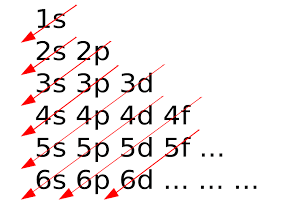
The electronic configuration of an element is $1{s^2}2{s^2}2{p^6}3{s^2}3{p^6}3{d^5}4{s^1}$. This represents:
A) excited state
B) ground state
C) cationic state
D) anionic state
Answer
582.9k+ views
Hint: The electronic configuration describes the filling of the electrons in different orbitals. The electrons are filled in the orbitals according to the Aufbau principle.
Complete step-by-step answer:
We know that, according to the Aufbau principle, the electrons are placed according to the order $1s\,2s\,2p\,3s\,3p\,4s\,3d\,4p\,5s\,4d\,5p\,6s\,4f\,5d\,6p\,7s$…….

There are also some exceptions to this Aufbau principle such as for ruthenium, silver, platinum and rhodium.
1. The given electronic configuration has 24 electrons. We know that chromium has the atomic number 24 in the periodic table. Chromium is placed in the 6th group. It is a transition element and is placed in the D-block of the periodic table. The filling of these 24 electrons in different orbitals according to Aufbau principle, we get the electronic configuration $1{s^2}2{s^2}2{p^6}3{s^2}3{p^6}3{d^5}4{s^1}$. This is the ground state electronic configuration of the element Chromium.
2. The same configuration can be exhibited by $(Mn^+)$ when it loses one electron and acquires a cationic state. So, this is also correct.
Hence, option (B) & (C) is correct.
Additional Information:
Dmitri Ivanovich Mendeleev on February 17, 1869 has first formulated the modern periodic table. The periodic table contains all the elements known to us. All the elements in the periodic table are grouped according to definite periods and groups. The elements placed in a particular group have similar properties such as chemical properties, reactivity etc. The elements in a group or in a period follow definite trends in size, atomic number etc.
Note: The students may get confused about writing down the electronic configuration of an element in the ground state and in the excited state. In the electronic configuration of an element in its excited state, the electrons in the outermost shell are placed in a higher energy orbital than that of the outermost electron in the ground state of that element.
Complete step-by-step answer:
We know that, according to the Aufbau principle, the electrons are placed according to the order $1s\,2s\,2p\,3s\,3p\,4s\,3d\,4p\,5s\,4d\,5p\,6s\,4f\,5d\,6p\,7s$…….

There are also some exceptions to this Aufbau principle such as for ruthenium, silver, platinum and rhodium.
1. The given electronic configuration has 24 electrons. We know that chromium has the atomic number 24 in the periodic table. Chromium is placed in the 6th group. It is a transition element and is placed in the D-block of the periodic table. The filling of these 24 electrons in different orbitals according to Aufbau principle, we get the electronic configuration $1{s^2}2{s^2}2{p^6}3{s^2}3{p^6}3{d^5}4{s^1}$. This is the ground state electronic configuration of the element Chromium.
2. The same configuration can be exhibited by $(Mn^+)$ when it loses one electron and acquires a cationic state. So, this is also correct.
Hence, option (B) & (C) is correct.
Additional Information:
Dmitri Ivanovich Mendeleev on February 17, 1869 has first formulated the modern periodic table. The periodic table contains all the elements known to us. All the elements in the periodic table are grouped according to definite periods and groups. The elements placed in a particular group have similar properties such as chemical properties, reactivity etc. The elements in a group or in a period follow definite trends in size, atomic number etc.
Note: The students may get confused about writing down the electronic configuration of an element in the ground state and in the excited state. In the electronic configuration of an element in its excited state, the electrons in the outermost shell are placed in a higher energy orbital than that of the outermost electron in the ground state of that element.
Recently Updated Pages
Master Class 11 Economics: Engaging Questions & Answers for Success

Master Class 11 English: Engaging Questions & Answers for Success

Master Class 11 Social Science: Engaging Questions & Answers for Success

Master Class 11 Biology: Engaging Questions & Answers for Success

Class 11 Question and Answer - Your Ultimate Solutions Guide

Master Class 11 Business Studies: Engaging Questions & Answers for Success

Trending doubts
10 examples of friction in our daily life

One Metric ton is equal to kg A 10000 B 1000 C 100 class 11 physics CBSE

Difference Between Prokaryotic Cells and Eukaryotic Cells

1 Quintal is equal to a 110 kg b 10 kg c 100kg d 1000 class 11 physics CBSE

Explain zero factorial class 11 maths CBSE

What is a periderm How does periderm formation take class 11 biology CBSE




